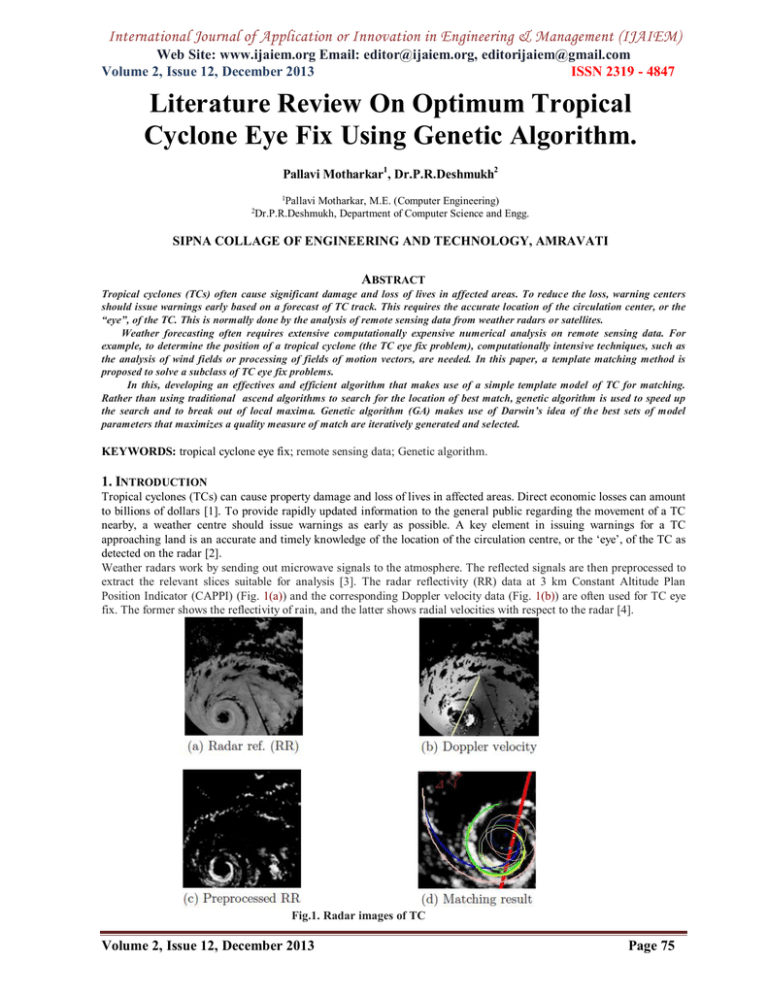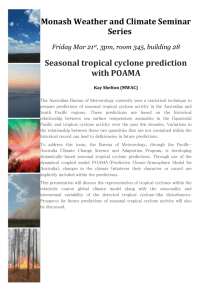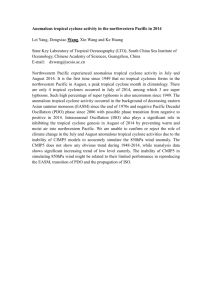Literature Review On Optimum Tropical Cyclone Eye Fix Using Genetic Algorithm.
advertisement

International Journal of Application or Innovation in Engineering & Management (IJAIEM) Web Site: www.ijaiem.org Email: editor@ijaiem.org, editorijaiem@gmail.com Volume 2, Issue 12, December 2013 ISSN 2319 - 4847 Literature Review On Optimum Tropical Cyclone Eye Fix Using Genetic Algorithm. Pallavi Motharkar1, Dr.P.R.Deshmukh2 1 Pallavi Motharkar, M.E. (Computer Engineering) Dr.P.R.Deshmukh, Department of Computer Science and Engg. 2 SIPNA COLLAGE OF ENGINEERING AND TECHNOLOGY, AMRAVATI ABSTRACT Tropical cyclones (TCs) often cause significant damage and loss of lives in affected areas. To reduce the loss, warning centers should issue warnings early based on a forecast of TC track. This requires the accurate location of the circulation center, or the “eye”, of the TC. This is normally done by the analysis of remote sensing data from weather radars or satellites. Weather forecasting often requires extensive computationally expensive numerical analysis on remote sensing data. For example, to determine the position of a tropical cyclone (the TC eye fix problem), computationally intensive techniques, such as the analysis of wind fields or processing of fields of motion vectors, are needed. In this paper, a template matching method is proposed to solve a subclass of TC eye fix problems. In this, developing an effectives and efficient algorithm that makes use of a simple template model of TC for matching. Rather than using traditional ascend algorithms to search for the location of best match, genetic algorithm is used to speed up the search and to break out of local maxima. Genetic algorithm (GA) makes use of Darwin’s idea of the best sets of model parameters that maximizes a quality measure of match are iteratively generated and selected. KEYWORDS: tropical cyclone eye fix; remote sensing data; Genetic algorithm. 1. INTRODUCTION Tropical cyclones (TCs) can cause property damage and loss of lives in affected areas. Direct economic losses can amount to billions of dollars [1]. To provide rapidly updated information to the general public regarding the movement of a TC nearby, a weather centre should issue warnings as early as possible. A key element in issuing warnings for a TC approaching land is an accurate and timely knowledge of the location of the circulation centre, or the ‘eye’, of the TC as detected on the radar [2]. Weather radars work by sending out microwave signals to the atmosphere. The reflected signals are then preprocessed to extract the relevant slices suitable for analysis [3]. The radar reflectivity (RR) data at 3 km Constant Altitude Plan Position Indicator (CAPPI) (Fig. 1(a)) and the corresponding Doppler velocity data (Fig. 1(b)) are often used for TC eye fix. The former shows the reflectivity of rain, and the latter shows radial velocities with respect to the radar [4]. Fig.1. Radar images of TC Volume 2, Issue 12, December 2013 Page 75 International Journal of Application or Innovation in Engineering & Management (IJAIEM) Web Site: www.ijaiem.org Email: editor@ijaiem.org, editorijaiem@gmail.com Volume 2, Issue 12, December 2013 ISSN 2319 - 4847 Since a TC is a system with spiraling rainbands whose circulation center is the eye, the zero isodop, or the line with zero radial velocity with respect to the radar, is where the TC center should lie [5]. The radars used by the Hong Kong Observatory take six minutes to update both types of data. They cover a range of 512km, with spatial resolution of several kilometers. Since TCs in the proximity of hundreds of kilometers from a city fall into the range of radars and pose the greatest threat, it focuses on the eye fix process from radar images [6, 7]. Though the techniques for the collection of atmospheric observations have mostly been automated, TC eye fix is still done manually or semiautomated. This simple TC eye fix problem is practically challenging and difficult for a number of reasons:• Every TC has the easily recognizable feature of an eye; • The location of the TC centre could vary with altitude; • Each data source has its own properties and also available at different time intervals; • The structure of the TC at different stages is different; and • Lack of universally accepted TC track information for evaluation. TC Forecasters estimate the center location by tracing the movement of spiral rainbands using consecutive remote sensing images, or by overlaying spiral templates on remote sensing images for the best match [2]. However, these techniques are not completely objective. In contrast, automated TC eye fix methods, such as wind field analysis and pattern matching, employ objective measures. In wind field analysis, the TC center is found by analyzing the motion field [3], which is built using the TREC algorithm [4] or by cloud feature tracking [5]. For pattern matching, the TC eye is fixed by finding the best match of a predefined TC model, whose parameters are estimated from remote sensing data. A method for ideal TCs is to identify the shear pattern [8]. The spiral rainband of a TC is modeled by the equation, r = aeθ cot α , where a and α are found by transformation techniques. Templates generated by the estimated parameters are used to match against radar images at latitude-longitude positions [9]. These eye fix methods require computationally expensive operations such as motion vector field construction, parameter estimation, and extensive block or object matching. With the large volume and rate of data, this problem is often solved using mainframe computers or clusters to generate timely results [10]. 2. PREVIOUS WORK Firstly, Most of the methods are manual or semiautomated [1] and that based on satellite images [1, 2]. As radar data normally have a higher resolution and are updated frequently, better performance can be expected [2]. As timely and accurate estimates of the centre position and motion of TCs are essential, the focus in this is on the eye fix process using radar data, which normally have higher spatial and temporal resolution than satellite images. The radar reflectivity data at 3 km Constant Altitude Plan Position Indicator (CAPPI) and the corresponding Doppler velocity data are used simultaneously. The S-band Doppler radars used by the Hong Kong Observatory take 6 min to update both types of data [1]. This covers a radius of up to 512 km, with radial spatial resolution of 250 m. Early TC eye fix methods are completely manual. Forecasters estimate the centre location by tracing the movement of spiral rainbands using consecutive remote sensing images, or by overlaying spiral templates on remote sensing images for the best match [2]. Attempts to automate or semiautomate the TC eye fix process categories as: pattern matching and wind field analysis. In pattern matching, a TC eye is fixed by finding the best match between predefined TC models and remote sensing data. An example, where the TC centres is defined as the geometric centre of the TC eye wall. By using airborne radar data, the forecaster first subjectively determines a centre point. From the selected point, the inner edge of the eye wall is found. The centre of the circle that best fits the location of the inner edge of the eye wall gives an objective estimate of the centre. Secondly, Rinehart developed the Tracking Radar Echoes by Correlation (TREC) method for motion field construction using radar images [2, 3]. In TREC, two scans of Plan Position Indicator (PPI) reflectivity data measured at the same elevation angle, separated a few minutes apart, are used. The analysis proceeds by dividing the first scan into a number of equal-sized two-dimensional arrays of pixels. Each array is correlated with the possible arrays of the same size in the second scan to find the best match. The location of the second array with the highest correlation determines the end point of motion vector. The motion field constructed using the TREC algorithm has been adopted in systems such as SWIRLS for TC observation. As another example, a single ground-based radar TC wind retrieval technique, the ground-based velocity track display (GBVTD), is developed to deduce the TC’s inner-core wind fields at a specified altitude. By maximizing GBVTDretrieved mean tangential wind [4], a GBVTD-Simplex centre finding algorithm is developed to objectively estimate the TC vorticity centre. Recently, the model was subsequently improved to have six parameters to limit the extent of rainbands [5, 6], allowing the the eye to vary in size during the TC’s lifetime, and modelling the eye wall as well. It used a genetic algorithm (GA) to speed up the search of the parameter set for the best match. Templates are thus generated as candidates of the GA, and a fitness function is defined. There is an order of magnitude of improvement in terms of efficiency with respect to that makes Volume 2, Issue 12, December 2013 Page 76 International Journal of Application or Innovation in Engineering & Management (IJAIEM) Web Site: www.ijaiem.org Email: editor@ijaiem.org, editorijaiem@gmail.com Volume 2, Issue 12, December 2013 ISSN 2319 - 4847 makes use of transformation techniques. To further improve the speed and accuracy, we also make use of temporal information in the GA-based eye fix algorithm [5, 6] This method gives an improvement of 35% in speed and 20% in accuracy compared to the one without the use of temporal information. Though effective, these techniques require TCs to have the same sets of features defined in the models. Thus, they cannot be used effectively when the TC is forming, dissipating, or partially out of radar range. In contrast, wind field analysis methods exploit both spatial and temporal information and therefore can be used even when a well-defined TC eye is missing. In wind field analysis, the TC centre is found by analyzing the motion field constructed from a sequence of remote sensing images [4]. 3. PROPOSED APPROACH Proposed solution establishes TC eye fix method using genetic algorithm which is useful for the affected tropical areas lives. Genetic algorithms (GAs) are search methods based on principles of natural selection and genetics developed by Fraser, Bremermann; Holland. Another important concept of GAs is the notion of population. Unlike traditional search methods, genetic algorithms rely on a population of candidate solutions. The population size, which is usually a user-specified parameter, is one of the important factors affecting the scalability and performance of genetic algorithms. Genetic algorithm is used to find the template that best fits the image. To evolve solutions by using the following steps: 1. Initialization. The initial population of candidate solutions is usually generated randomly across the search space. However, domainspecific knowledge or other information can be easily incorporated. 2. Evaluation. Once the population is initialized or an offspring population is created, the fitness values of the candidate solutions are evaluated. 3. Selection. Selection allocates more copies of those solutions with higher fitness values and thus imposes the survival fittest mechanism on the candidate solutions. 4. Recombination. Recombination combines parts of two or more parental solutions to create new, possibly better solutions (i.e. offspring). There are many ways of accomplishing this and competent performance depends on a properly designed recombination mechanism. 5. Mutation. While recombination operates on two or more parental chromosomes, mutation locally but randomly modifies a solution. 6. Replacements. The offspring population created by selection, recombination, and mutation replaces the original parental population. Many replacement techniques such as elitist replacement, generation-wise replacement and steady-state replacement methods are used in GAs. 7. Repeat steps 2–6 until a terminating condition is met. 8. After generating the cyclone image using proposed system, it then compare with other tropical database images and evaluate the effective and efficient performance and then it can gives the optimum predicted tropical cyclone image. 4. CONCLUSION Proposed prediction scheme is a potential tool to increase the accuracy in predicting tropical cyclone intensity. Timeseries adjustment function is proposed to reflect the time sensitive to the similarity measures. Ten years of data comprising observation samples of tropical cyclone passing through Hong Kong is used for the approach. Proposed model is optimal for use that gives tropical cyclone behaviour which can be useful in the course of providing an accurate forecast. In this scheme, discovering new approaches in designing reformative forecasting models to predict the intensity of tropical cyclone using methodologies at different levels that may be reliable for the collected data types, more efficient and effective in term of predicted accuracy & computational cost, and more scalable to future system expansion. It also proposes the time-series adjustment to measure the similarity of samples on consecutive observation of a tropical cyclone. Volume 2, Issue 12, December 2013 Page 77 International Journal of Application or Innovation in Engineering & Management (IJAIEM) Web Site: www.ijaiem.org Email: editor@ijaiem.org, editorijaiem@gmail.com Volume 2, Issue 12, December 2013 ISSN 2319 - 4847 Proposed approach directed towards improving the matching module’s efficiency and matching accuracy, with special emphasis on improving the algorithm for finding the optimal tropical cyclone intensity. REFERENCE [1] Hong Kong Observatory: http://www.hko.gov.hk/. [2] Sivaramakrishnan, M.V., Selvam,.: On the use of the spiral overlay technique for estimating the center positions of tropical cyclones from satellite photographs taken over the Indian region. In: Proc. 12th Radar Meteor. Conf. (1966) 440–446. [3] Wood, V.T.: A technique for detecting a tropical cyclone center using a Doppler radar. Journal of Atmospheric and Oceanic Technology 11 (1994) 1207–1216. [4] Wong, K.Y., Yip, C.L., Li, P.W., Tsang, W.W.: Automatic template matching method for tropical cyclone eye fix. In: Proc. ICPR 2004. [5] Yip, C.L., Wong, K.Y.: Tropical cyclone eye fix using genetic algorithm. Technical report, Dept. Of Comp. Sci. & Info. Sys. The University of Hong Kong (2004). [6] Hong Kong Observatory (HKO). 2006. Hong Kong Observatory – Official Authority for Hong Kong Weather Forecast, web page. [7] Wong KY, Yip CL, Li PW. 2007. Automatic tropical cyclone eye fix using genetic algorithm Expert Systems with Application[2008]. [8] Forrest, S., 1993, Genetic algorithms: Principles of natural selection applied to computation, Science 261:872–878. [9] Goldberg DE. 1989. Genetic Algorithm in Search, Optimization Machine Learning. [10] Lai, E.S.T.: TREC application in tropical cyclone observation. ESCAP/WMO Typhoon Committee Annual Review (1998). [11] Tuttle, J., Gall, R.: A single-radar technique for estimating the winds in tropical cyclones. Bulletin of the AMS 80 (1996) 653–668 Volume 2, Issue 12, December 2013 Page 78







